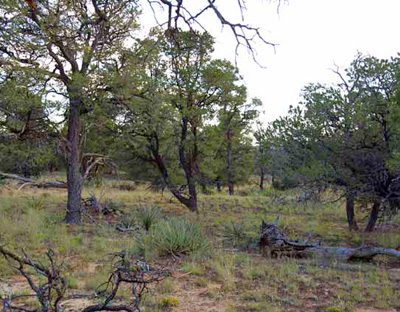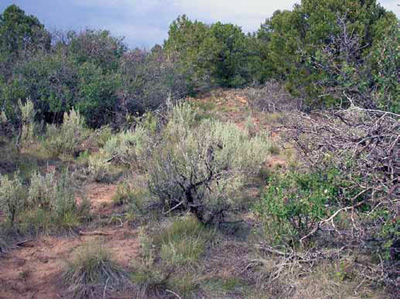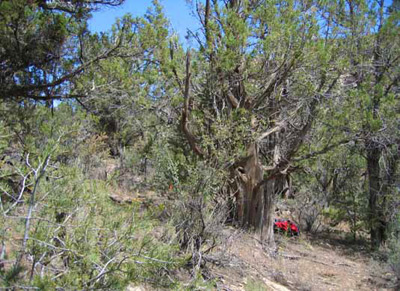Pinyon-juniper woodlands are remarkably varied, not only in the structure of stands and the species comprising them, but also in the ways they are classified.
Species Composition and Stand Structure
Pinyon-juniper woodlands exhibit a wide variety of stand structures and compositions, which are influenced by local climate, topography, growing conditions and disturbance regimes. Five common species of juniper occur across the American Southwest: redberry juniper (Juniperus coahuilensis), alligator juniper (J. deppeana), one-seed juniper (J. monosperma), Utah juniper (J. osteosperma), and Rocky Mountain juniper (J. scopulorum). Redberry juniper is considered a hybrid of alligator and one-seed juniper. Rocky Mountain juniper will hybridize with alligator, one-seed, and Utah junipers, among other species.
These species of juniper are associated with four species of pinyon pine: two-needle, or common pinyon (Pinus edulis), and singleleaf pinyon (P. monophylla), which are the most widespread; and Mexican pinyon (Pinus cembroides) and border pinyon (P. discolor), which occur at lower elevations in Arizona, New Mexico, Texas, and Mexico. Some taxonomists consider border pinyon and Mexican pinyon to be similar enough in characteristics, such as flowering time and needle number, that they are treated as one species (Pavek 1994). Two-needle pinyon, which has needles occurring in bundles (fascicles) of two, and singleleaf pinyon, with needles occurring singly, hybridize where their ranges overlap, creating populations of trees with one- and two-needled fascicles on the same tree. Two-needle pinyon is also known to hybridize with Mexican pinyon.
The extensive networks of lateral roots and deep taproots in mature pinyon and juniper trees are highly effective at extracting moisture from the soil, thereby reducing the amount of moisture available to understory vegetation. As a result, understory vegetation has been reported to decrease with increasing pinyon and juniper density, and to rebound dramatically after removal of the trees by burning, thinning, or some other form of disturbance (Davenport et al. 1998).
Classification of Pinyon-Juniper Woodlands
Pinyon-juniper woodlands have been classified in a number of ways, using variables such as climate zones, understory composition, overstory species dominance, soils, climate, and elevation. Romme et al. (2008) identified 3 major types, based on historical stand structure, disturbance regimes, and landscape dynamics: (1) pinyon-juniper savanna, (2) pinyon-juniper wooded shrubland, and (3) pinyon-juniper persistent woodland (Table 1).
| Table 1. Pinyon-juniper woodland types. | |||
| Savanna | Wooded Shrubland | Persistent Woodland | |
Precipitation | Receives mainly summer precipitation. Bi-modal precipitation in some areas. | Most often occurring (but not restricted to) areas of winter precipitation. | Receives mainly winter precipitation. |
Soils | Deeper, fine-textured soils support a range of vegetation types. | Wide variety of substrates. | Shallow, often rocky soils do not support continuous vegetative cover. |
Terrain | Gentle terrain- valleys, basins, and foothills. | Wide variety of topography- plains, valleys, and lower montane. | Rugged upland sites and steep, rocky terrain. |
Stand Structure | Open savanna-like stand structure, supports low density of trees and shrubs, and dense herbaceous growth: grasses, forbs, and annuals. | Areas of woodland expansion and contraction. Shifts from herbaceous, to shrub, to tree dominance over time, in the absence of fire. Often shrub- dominated, with trees colonizing when growing conditions are favorable. | Multi-aged stand structure. Range of tree densities and canopy cover, depending on site conditions. |
Historical Fire Regime | Frequent, lower-intensity surface fires maintain grasses and open stand structure. Few barriers to fire spread. | Infrequent, high-severity fires and patchy, mixed-severity fires. | Infrequent high-severity fire. Significant barriers to fire spread: cliffs, canyons, exposed rock, topographic isolation. |
Impacts: Livestock & Fire Suppression | Increased density of younger trees, reduced ground cover, and higher-severity fires when they occur. | Increased tree density, cover, and canopy closure, decreased shrub density, and larger higher-severity fires when they occur. | Little impact to fire frequency |

NPS photo.
Pinyon-juniper savanna
Pinyon-juniper savanna is characterized by an open savanna-like stand structure, with low densities of trees and shrubs, and a dense herbaceous groundcover of grasses and forbs. It extends onto portions of the southern Colorado Plateau and is commonly found in basins and foothills of southern and central Arizona and New Mexico, where deep, fine-textured soils support a range of vegetation types. The majority of precipitation in pinyon-juniper savanna takes the form of monsoon rains, which occur during the summer growing season and tend to favor the growth of warm season grasses. Common warm season grass species found in pinyon-juniper savanna include blue grama (Bouteloua gracilis) and other species of grama grass (B. curtipendula, B. hirsuta, B. eriopoda), New Mexico muhly (Muhlenbergia pauciflora), curlyleaf muhly (Muhlenbergia setifolia), and needle and thread grass (Hesperostipa spp.). It is hypothesized that a regime of frequent, low-intensity surface fires is responsible for maintaining the open stand structure and dense herbaceous growth of pinyon-juniper savanna.

NPS Photo.
Pinyon-juniper wooded shrubland
Pinyon-juniper wooded shrubland is often found in, but is not restricted to, areas where winter precipitation predominates, including portions of northern Arizona and New Mexico. It can occur on a wide variety of substrates and terrain, from plains and valleys to lower montane areas. Pinyon-juniper wooded shrublands are areas of woodland expansion and contraction, which often border other forest types or vegetation communities. In the absence of fire, pinyon-juniper wooded shrublands shift from grass and forb-dominated, to shrub-dominated, and to tree-dominated communities over time. Stand structure and vegetation composition are influenced by growing conditions, infrequent stand-replacing fires, and occasional mixed-severity fires. Due to discontinuous fine fuels, low-intensity surface fires have historically had a limited influence on stand structure and dynamics (Romme et al. 2008). Typical shrub species associated with pinyon-juniper wooded shrubland include big sage (Artemisia tridentata) and other Artemisia species, antelope bitterbrush (Purshia tridentata), rabbitbrush (Chrysothamnus spp. and Ericameria spp.), mountain mahogany (Cercocarpus spp.), and snakeweed (Gutierrezia spp.)

NPS Photo.
Pinyon-juniper persistent woodland
The third type of pinyon-juniper woodland—persistent woodland—occurs throughout the southwestern United States, usually in areas where winter precipitation predominates, or where precipitation is bi-modal. In many cases, persistent woodland sites are unproductive, with thin soils and sparse herbaceous and shrub cover. A range of tree densities and canopy cover occur, influenced by site conditions and history of disturbance. Persistent woodlands often exhibit a multi-aged stand structure that includes some very old trees. They often occur on rocky terrain and rugged upland sites where topographic features such as cliffs, canyons, and large areas of exposed rock create significant barriers to fire spread.
Repeat aerial photography, examination of tree rings, and permanent study plots reveal an increase in tree densities and canopy closure (infill) in many persistent woodlands over the past century. The factors driving this increase are not fully understood, but are more likely to include past livestock grazing or favorable climatic conditions, than fire exclusion (Romme et al. 2008).
Part of a series of articles titled Pinyon-Juniper Woodlands.
Last updated: February 3, 2015
